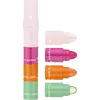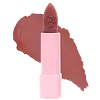What's inside
What's inside
 Key Ingredients
Key Ingredients

 Benefits
Benefits

 Concerns
Concerns

 Ingredients Side-by-side
Ingredients Side-by-side

Caprylic/Capric Triglyceride
MaskingEthylhexyl Palmitate
EmollientPolybutene
Diisostearyl Malate
EmollientHelianthus Annuus Seed Wax
Skin ConditioningEuphorbia Cerifera Wax
Bis-Diglyceryl Polyacyladipate-2
EmollientTocopheryl Acetate
AntioxidantEthylhexylglycerin
Skin ConditioningPhenoxyethanol
PreservativeParfum
MaskingCI 15850
Cosmetic ColorantCI 45380
Cosmetic ColorantCI 45410
Cosmetic ColorantCI 77492
Cosmetic ColorantCI 77891
Cosmetic ColorantMica
Cosmetic ColorantTin Oxide
AbrasiveTridecyl Trimellitate
EmollientC12-15 Alkyl Benzoate
AntimicrobialDibutyl Lauroyl Glutamide
Skin ConditioningDibutyl Ethylhexanoyl Glutamide
Skin ConditioningOctyldodecanol
EmollientIsostearic Acid
CleansingCI 42090
Cosmetic ColorantCaprylic/Capric Triglyceride, Ethylhexyl Palmitate, Polybutene, Diisostearyl Malate, Helianthus Annuus Seed Wax, Euphorbia Cerifera Wax, Bis-Diglyceryl Polyacyladipate-2, Tocopheryl Acetate, Ethylhexylglycerin, Phenoxyethanol, Parfum, CI 15850, CI 45380, CI 45410, CI 77492, CI 77891, Mica, Tin Oxide, Tridecyl Trimellitate, C12-15 Alkyl Benzoate, Dibutyl Lauroyl Glutamide, Dibutyl Ethylhexanoyl Glutamide, Octyldodecanol, Isostearic Acid, CI 42090
Octyldodecanol
EmollientRicinus Communis Seed Oil
MaskingSilica
AbrasiveSynthetic Wax
AbrasiveEthylhexyl Palmitate
EmollientMica
Cosmetic ColorantTridecyl Trimellitate
EmollientIsononyl Isononanoate
EmollientBeeswax
Emulsion StabilisingHydrogenated Microcrystalline Wax
Emulsion StabilisingCaprylic/Capric Triglyceride
MaskingTocopheryl Acetate
AntioxidantPhenoxyethanol
PreservativePentaerythrityl Tetra-Di-T-Butyl Hydroxyhydrocinnamate
AntioxidantLycium Chinense Fruit Extract
AntioxidantCI 15850
Cosmetic ColorantCI 77491
Cosmetic ColorantCI 77492
Cosmetic ColorantCI 77499
Cosmetic ColorantOctyldodecanol, Ricinus Communis Seed Oil, Silica, Synthetic Wax, Ethylhexyl Palmitate, Mica, Tridecyl Trimellitate, Isononyl Isononanoate, Beeswax, Hydrogenated Microcrystalline Wax, Caprylic/Capric Triglyceride, Tocopheryl Acetate, Phenoxyethanol, Pentaerythrityl Tetra-Di-T-Butyl Hydroxyhydrocinnamate, Lycium Chinense Fruit Extract, CI 15850, CI 77491, CI 77492, CI 77499
Ingredients Explained
These ingredients are found in both products.
Ingredients higher up in an ingredient list are typically present in a larger amount.
This ingredient is an emollient, solvent, and texture enhancer. It is considered a skin-softener by helping the skin prevent moisture loss.
It helps thicken a product's formula and makes it easier to spread by dissolving clumping compounds.
Caprylic Triglyceride is made by combining glycerin with coconut oil, forming a clear liquid.
While there is an assumption Caprylic Triglyceride can clog pores due to it being derived from coconut oil, there is no research supporting this.
Learn more about Caprylic/Capric TriglycerideCi 15850 is the pigment color red. It is an azo dye and created synthetically.
Azo dyes need to be thoroughly purified before use. This allows them to be more stable and longer-lasting.
This ingredient is common in foundations, lipsticks, and blushes. This color is described as brown/orangey red.
It has many secondary names such as Red 6 and Red 7. According to a manufacturer, Red 6 usually contains aluminum.
Learn more about CI 15850Ci 77492 is also hydrated iron III oxide. It's sole purpose is to give a yellow hue to products.
Iron III oxides are classified as inorganic chemicals for coloring.
Synthetically created Ci 77492 is considered safer than those naturally found. This is because the synthetically created version may contain less impurities. Iron oxides are generally non-toxic and non-allergenic.
Learn more about CI 77492Ethylhexyl Palmitate, also known as octyl palmitate, is created from 2-ethylhexyl alcohol and palmitic acid. It is a fatty acid ester.
The fatty acid content of Ethylhexyl Palmitate makes it an emollient. Emollients help soften and hydrate your skin by trapping moisture within.
Ethylhexyl Palmitate is also used to help improve the texture of cosmetics. It helps other ingredient dissolve in products and help disperse ingredients more evenly.
You'll likely find this ingredient in sunscreen, as it is often used to mix UV-blocking ingredients such as avobenzone and ethylhexyl triazone.
It can also help stabilize the fragrances in a product as a fragrance fixative.
Ethylhexyl Palmitate can be used to substitute mineral oil.
Due to its high fatty acid content, it may not be fungal-acne safe.
Learn more about Ethylhexyl PalmitateMica is a naturally occurring mineral used to add shimmer and color in cosmetics. It can also help improve the texture of a product or give it an opaque, white/silver color.
Serecite is the name for very fine but ragged grains of mica.
This ingredient is often coated with metal oxides like titanium dioxide. Trace amounts of heavy metals may be found in mica, but these metals are not harmful in our personal products.
Mica has been used since prehistoric times throughout the world. Ancient Egyptian, Indian, Greek, Roman, Aztec, and Chinese civilizations have used mica.
Learn more about MicaOctyldodecanol is a fatty alcohol. It is primarily used to enhance the texture of products.
As an emulsifier, Octyldodecanol helps prevent the oils and waters from separating. It also prevents ingredients from creating foam when shaken.
Octyldodecanol is created by reducing fatty acid to an alcohol.
Due to its high molecular weight, it does not get absorbed into the skin.
Learn more about OctyldodecanolPhenoxyethanol is a preservative that has germicide, antimicrobial, and aromatic properties. Studies show that phenoxyethanol can prevent microbial growth. By itself, it has a scent that is similar to that of a rose.
It's often used in formulations along with Caprylyl Glycol to preserve the shelf life of products.
Tocopheryl Acetate is AKA Vitamin E. It is an antioxidant and protects your skin from free radicals. Free radicals damage the skin by breaking down collagen.
One study found using Tocopheryl Acetate with Vitamin C decreased the number of sunburned cells.
Tocopheryl Acetate is commonly found in both skincare and dietary supplements.
Learn more about Tocopheryl AcetateTridecyl Trimellitate is a synthetic ingredient with emollient and skin conditioning properties. It also acts as a texture enhancer and helps products spread easily without feeling greasy.
As an emollient, it forms a light layer on the skin that keeps moisture in and improves water resistance. This is why you'll often find this ingredient in eye creams and other rich treatments.
This ingredient is seen as the elegant alternative to mineral oil.
Learn more about Tridecyl Trimellitate